In today’s beauty world, non-surgical cosmetic methods like filler injections are becoming increasingly popular among women. Filler injection helps restore volume to sunken areas and wrinkles on the face, creating a more youthful, harmonious appearance, without pain, no down time, and immediate results. So what is filler injection? What are the benefits and risks? This article will cover everything you need to know about injectable filler in Vietnam.
Overview of Dermal Fillers
First, let’s take a closer look at dermal fillers to understand what filler actually is and why it has become so popular.
What are dermal fillers?
Filler, or dermal filler, is a gel-like substance injected beneath the skin to fill hollow areas, reduce wrinkles, and restore volume to facial or body regions. The main ingredients are typically biocompatible with the human body, ensuring safe and natural aesthetic results.
Many people choose filler to correct facial imperfections, rejuvenate their appearance naturally, without complex surgeries or requiring recovery time. Results are visible immediately after treatment, with minimal downtime and effectiveness lasting from several months to a few years, depending on the filler type and injection area.

Why are dermal fillers used?
Filler injections offer many benefits, so it’s no coincidence that they have become so popular. As we age, everyone experiences a significant loss of collagen, which is a vital substance found throughout the body in the skin, muscles, bones, and connective tissues. Just imagine that as collagen gradually depletes, your skin begins to loosen, hollow areas appear, volume is lost, and elasticity declines, leading to sagging. Fortunately, filler injections can effectively and quickly address these issues by providing the following benefits:
- Smoothing wrinkles and folds: Reduces forehead lines, crow’s feet, smile lines, and marionette lines.
- Restoring volume and facial contouring: Enhances the nose bridge, fills hollow cheeks and temples, defines a V-line chin, plumps lips, and restores under-eye volume.
- Facial symmetry: Improves overall facial harmony without surgery.
- Scar treatment: Fills in acne scars or pitted scars.
- Skin rejuvenation: Stimulates natural collagen production, improving skin elasticity and firmness.
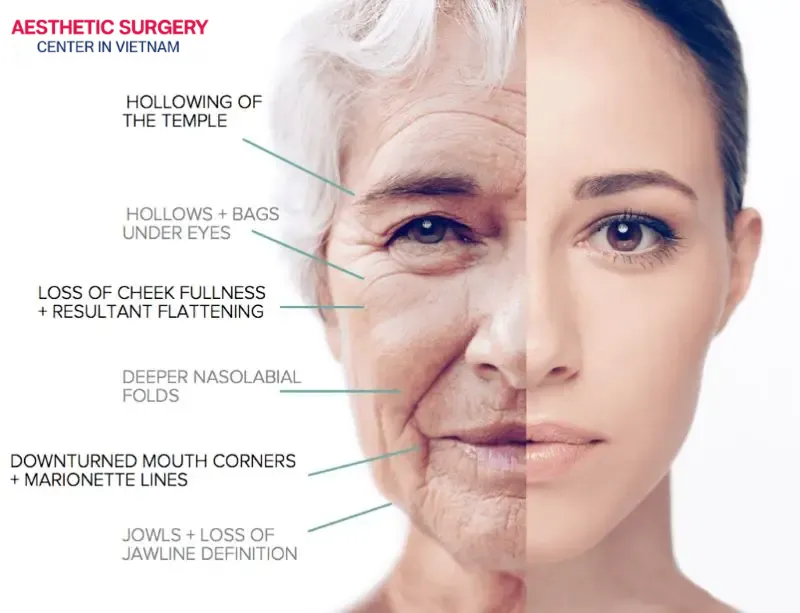
How common are dermal fillers?
The use of dermal fillers has become increasingly popular. In fact, it is one of the most commonly performed non-surgical cosmetic procedures worldwide.
According to statistics from the American Society of Plastic Surgeons, filler injections consistently rank among the top five most-performed minimally invasive procedures each year. In the United States alone, approximately 3 million people undergo filler treatments annually, reflecting the widespread public acceptance and demand for this method.
Filler has gained widespread popularity because it can address a variety of aesthetic concerns, from smoothing wrinkles and deep folds to contouring facial features such as the nose, chin, and lips, as well as restoring volume to hollow cheeks and temples. This versatility makes filler suitable for a broad range of clients with different cosmetic goals.
Moreover, dermal fillers are continuously being researched and improved, resulting in newer generations that offer enhanced safety, longer-lasting effects, and better biocompatibility. In particular, Hyaluronic Acid (HA)-based fillers are highly favored due to their dissolvable nature and the availability of reversal agents, ensuring a high level of safety for clients.
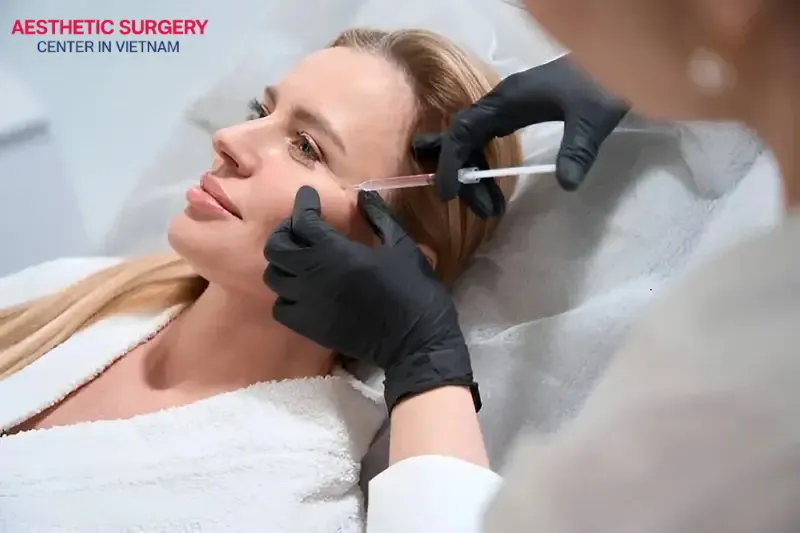
Filler injections in Vietnam is also trending. Scientific conferences on non-surgical aesthetics, especially those focused on filler applications, are held regularly to update professionals on new procedures and products, reflecting strong interest from both medical experts and clients.
However, as the popularity of fillers increases, it becomes even more crucial to choose reputable clinics and genuine, high-quality filler products to ensure safety and achieve optimal aesthetic results.
What are the types of dermal fillers?
Currently, there are many types of dermal fillers available on the market, mainly classified based on their ingredients and how long their effects last. Each type has its own characteristics, advantages, and disadvantages. Specifically, the main categories include:
Hyaluronic Acid (HA)
Hyaluronic Acid is a naturally occurring substance in the human body, especially found in the skin, eyes, and joints. It has the remarkable ability to retain up to 1,000 times its weight in water, helping the skin stay plump and hydrated. When injected into the skin, HA binds with water molecules to form a gel that fills volume loss, smooths out wrinkles, and enhances facial contours. This is the most commonly used and widely accepted injectable filler worldwide.
This filler can be used for a variety of purposes, including filling nasolabial folds, forehead wrinkles, crow’s feet, sunken cheeks, hollow temples, lip augmentation, chin sculpting, non-surgical nose enhancement, and under-eye hollows. The effects of HA fillers typically last from 6 months to 2 years, depending on the type of HA used, the injection area, dosage, and the individual’s skin and condition.
Advantages:
- High safety: Biocompatible with the human body, with minimal risk of adverse reactions.
- Reversible: If the results are unsatisfactory or complications occur, HA filler can be dissolved using the enzyme hyaluronidase, allowing the area to return to its original state.
- Natural-looking results: Provides soft, smooth, and harmonious enhancements.
Disadvantages: Results are not permanent and require periodic maintenance injections.
Popular brands: Juvederm, Restylane, Teoxane, Belotero, Revolax, Neuramis, Ammi…
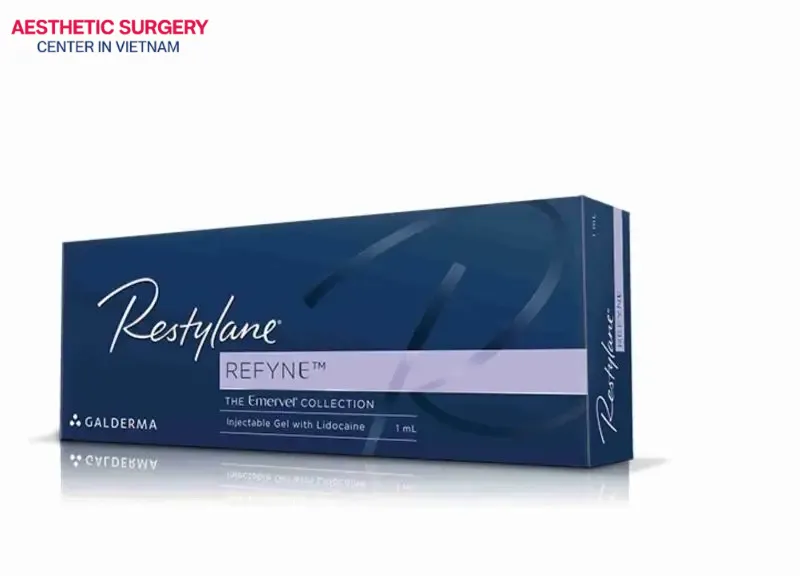
Calcium Hydroxylapatite (CaHA)
Calcium Hydroxylapatite (CaHA)-based filler is a mineral-like compound naturally found in human bones and teeth. CaHA filler typically comes in the form of microscopic spheres suspended in a smooth gel.
The gel provides immediate volume upon injection, while the CaHA microspheres stimulate the body’s natural collagen production over time. This enhances both the longevity of the results and the skin’s elasticity. CaHA fillers are commonly used for deep wrinkles, nasolabial folds, cheek volume restoration, jawline contouring, and hand rejuvenation. The effects typically last 12 to 24 months, depending on the individual’s skin condition and the area treated.
Advantages:
- Longer-lasting results compared to HA fillers
- Stimulates natural collagen production, improving skin quality over time
- Safe and rarely causes allergic reactions.
Disadvantages:
- Non-reversible: Unlike HA fillers, CaHA cannot be dissolved if the results are unsatisfactory
- Requires greater precision due to its thicker consistency.
Popular brand: Radiesse.
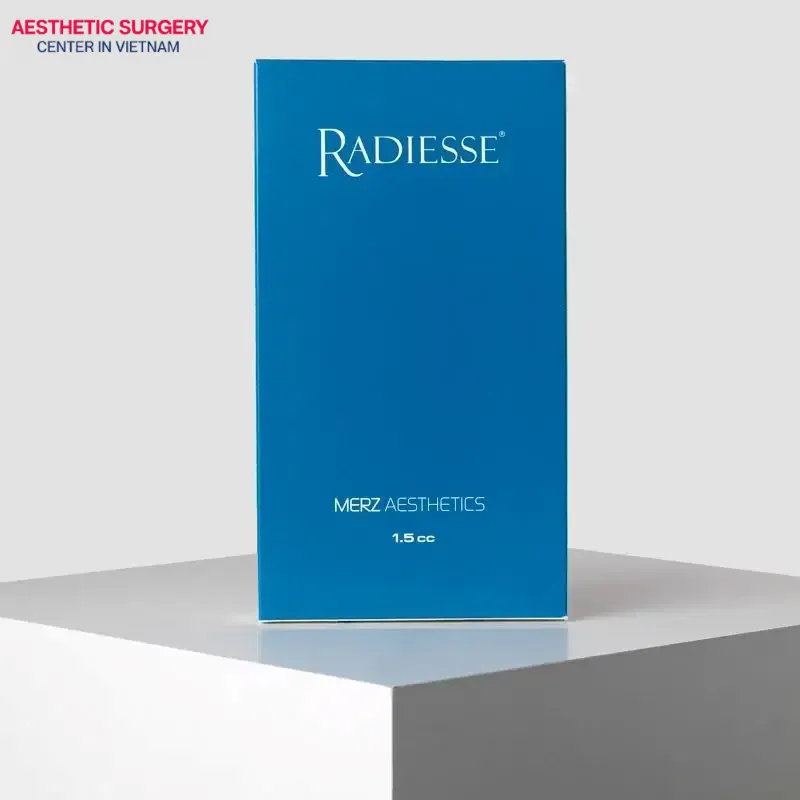
Poly-L-lactic Acid (PLLA)
Poly-L-lactic Acid (PLLA) is a synthetic, biodegradable, and biocompatible polymer known as a powerful collagen stimulator.
Unlike traditional fillers that provide immediate volume, PLLA works gradually by stimulating the body to produce its own natural collagen. After injection, the PLLA particles are slowly absorbed, triggering a mild inflammatory response that promotes collagen production around the injection site. This type of filler is commonly used to restore facial volume lost due to aging or conditions like HIV-related facial lipoatrophy, fill deep wrinkles, and improve overall skin texture.
One of the most notable features of PLLA is its long-lasting effect, often extending up to 2 years or more, since the results come from the body’s own collagen regeneration.
Advantages:
- Very long-lasting and natural-looking results due to collagen stimulation.
- Gradual improvement in skin quality and elasticity over time.
Disadvantages:
- No immediate results: Full effects may take weeks to months (usually require 2–3 treatment sessions spaced weeks apart).
- Non-reversible: Cannot be dissolved like HA fillers.
- Requires highly precise injection technique to avoid lumps or granulomas.
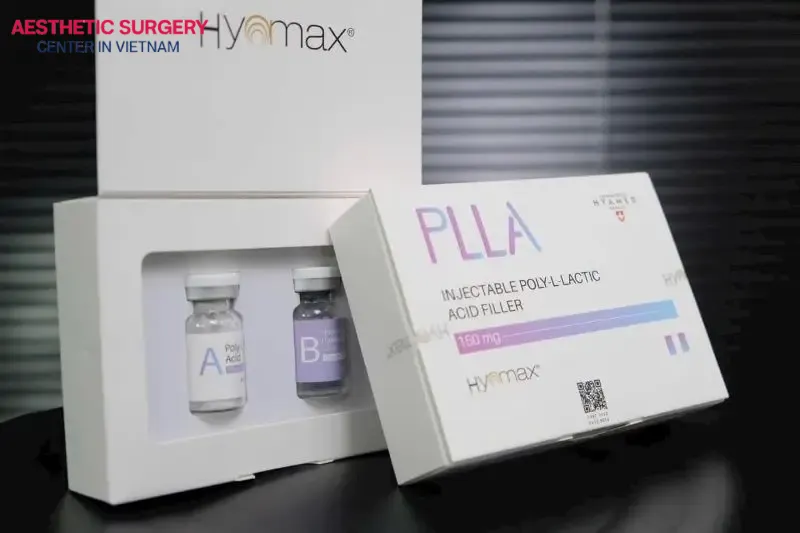
Polymethylmethacrylate (PMMA)
Polymethylmethacrylate (PMMA) is a type of dermal filler used in aesthetic procedures, with characteristics that differ significantly from more commonly used fillers like Hyaluronic Acid (HA). PMMA is a synthetic substance made up of tiny microspheres suspended in a collagen-based gel.
When injected into the skin, the initial collagen gel provides immediate volume. Over time, the body gradually absorbs this collagen and replaces it with natural connective tissue. The PMMA microspheres remain permanently in the tissue and stimulate the production of new collagen around them, helping to maintain long-term volume and structural support.
This type of filler is typically used for deep wrinkle correction, facial contouring, acne scar filling, and volume enhancement.
Advantages:
- Provides long-lasting aesthetic results, often for many years, without the need for frequent touch-ups like HA fillers.
- Stimulates collagen production, which naturally improves skin structure over time.
- Certain PMMA products are FDA-approved for cosmetic use.
Disadvantages:
Higher risk of side effects: Compared to dissolvable fillers, PMMA carries a greater risk of long-term complications such as granulomas, lumps, or persistent swelling.
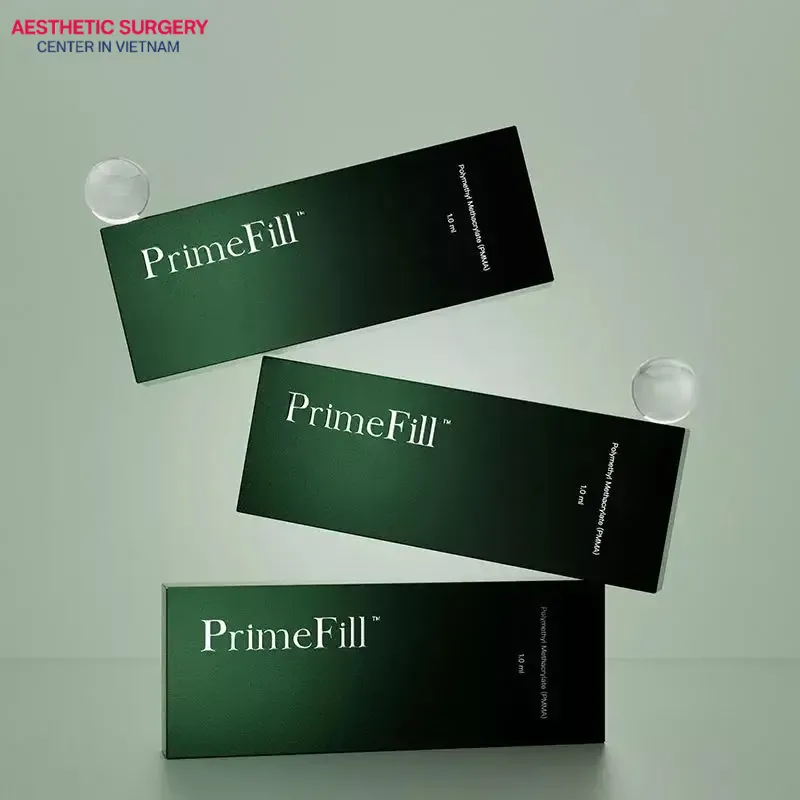
Procedure details
A medically standardized filler injection procedure is a key factor in ensuring safety and achieving the desired aesthetic results. Below is the typical process a doctor follows when administering filler to correct targeted areas:
What happens before a dermal filler procedure?
Step 1: The doctor will first conduct a direct consultation to assess your facial structure, skin condition, and listen to your aesthetic goals. Based on this evaluation, they will recommend a suitable filler type, dosage, and injection points to achieve the most natural and balanced outcome. At this step, you should inform your doctor about any existing health conditions, medical history, allergies, or medications you are currently taking.
Step 2: The clinic will carry out a general health check to confirm that you are medically fit to undergo the filler injection procedure.
Step 3: The doctor will then cleanse the targeted area, disinfect the skin, and apply a local anesthetic to minimize discomfort during the injection.
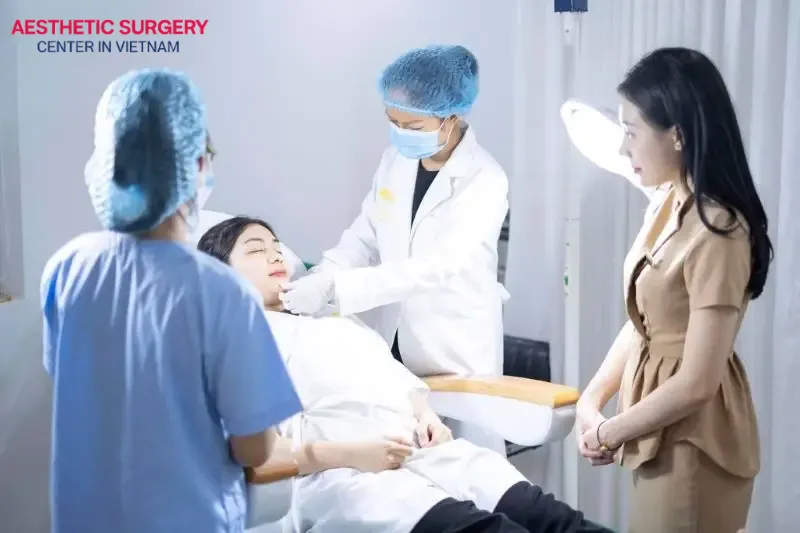
How does the filler injection process take place?
Once the local anesthetic has taken effect, the doctor will use a specialized ultra-fine needle or a blunt-tip cannula to inject the filler into the targeted dermal layers beneath the skin. This procedure requires precision and experience, as the filler must be delivered at the correct depth and location to avoid damaging blood vessels or nerves.
During the injection, the doctor may gently massage the area to help distribute the filler evenly and shape the desired contour.
The injection process is typically quick and efficient, usually taking 15-30 minutes, depending on the amount and size of the treatment areas.
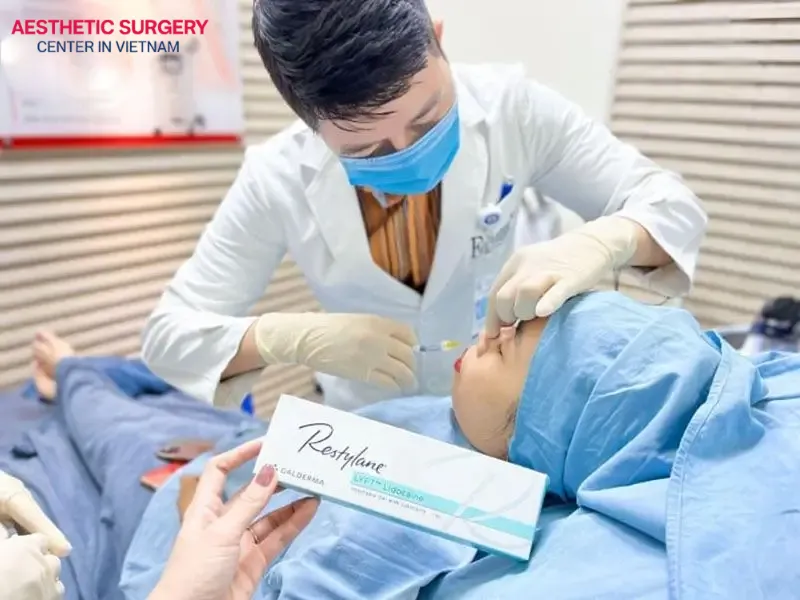
What happens after a dermal filler procedure?
After the procedure, you will be monitored for 15–30 minutes to ensure there are no immediate adverse reactions. The doctor will then provide specific aftercare instructions, including:
- Reduce swelling: Apply a gentle cold compress to minimize swelling and bruising.
- Avoid strong pressure: Do not massage, rub, or apply pressure to the treated area for the first few days.
- Limit exposure to heat: Avoid saunas, hot showers, and direct sun exposure.
- Avoid certain foods and substances: Refrain from eating spicy foods, seafood, and from consuming alcohol or stimulants.
- Stay hydrated: Drink plenty of water to help stabilize the filler and keep the skin moisturized.
Benefits and advantages of dermal filler injections
What are the advantages of dermal filler procedures?
Filler injections have become increasingly popular due to the outstanding benefits they offer. Below are the main advantages:
- Immediate and noticeable results: One of the greatest advantages of filler injections is that results can be seen almost immediately. After treatment, you’ll notice visible improvement in the treated area, such as smoothed wrinkles, fuller lips, or more defined facial contours. While there may be slight initial swelling, the final result usually becomes clear within a few days.
- No surgery required: Filler injections are non-invasive and don’t require incisions or general anesthesia. This significantly reduces the risks, pain, and downtime typically associated with surgical cosmetic procedures. Most clients can resume normal activities almost immediately after the treatment.
- Minimal recovery time: Since it’s a non-surgical procedure, recovery time is very short. Mild side effects like swelling, bruising, or redness generally subside within a few days. There’s no need for extended rest or time off work, making the process highly convenient.
- Adjustable and reversible: With Hyaluronic Acid (HA) fillers, the most commonly used type, you can easily adjust or reverse the results. If you’re unhappy with the outcome, your doctor can inject an enzyme called hyaluronidase to dissolve the filler. This flexibility offers greater peace of mind for clients.
- Natural and youthful appearance: Fillers restore volume lost due to aging, smooth out deep lines and wrinkles, and give the skin a plump, firm, and youthful look. All of this is achieved without scarring or any visible signs of surgery.
- Low risk and minimal side effects: When performed by a qualified specialist using high-quality products, filler injections are generally very safe. Common side effects (like swelling or bruising) are mild and temporary. Serious complications are rare when proper procedures are followed.
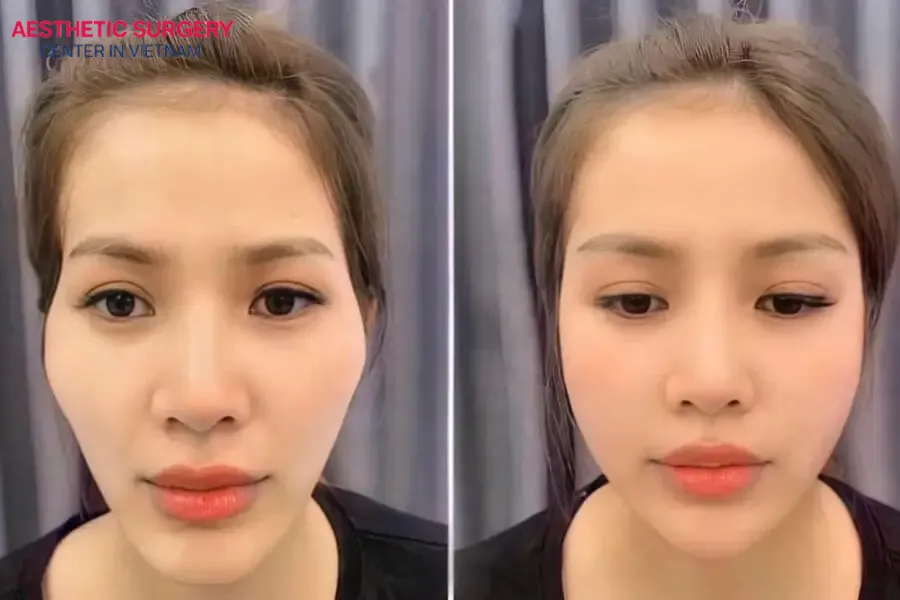
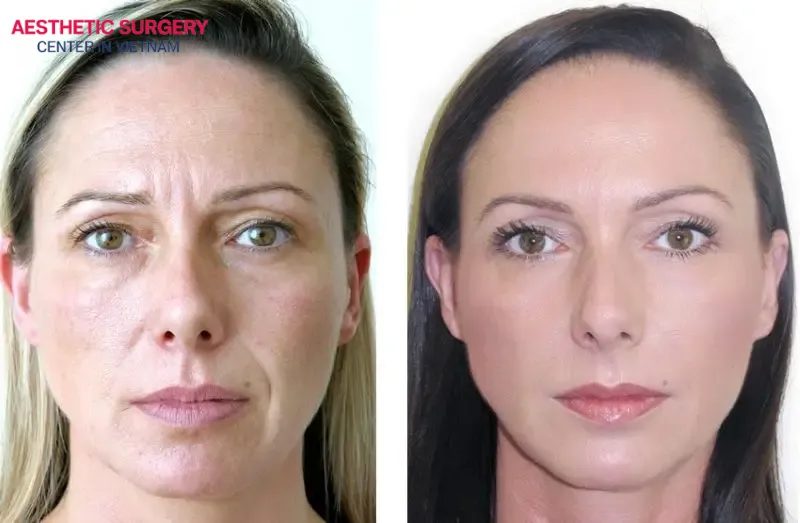
These advantages make dermal fillers an attractive option for those seeking fast, safe, and effective facial enhancement without the need for surgery.
What are the risks or complications of dermal fillers?
Although dermal fillers are generally considered safe, they still carry certain risks and potential complications.
Mild side effects
These reactions are quite common and typically appear shortly after the injection. They usually subside within a few days to a week.
- Swelling, redness, and bruising: Natural responses of the body to needle insertion.
- Mild pain or tenderness: Discomfort at the injection site.
- Itching or rash: Possible mild allergic reaction to the filler ingredients.
- Lumps or bumps: Small nodules may form if the filler is not evenly distributed.
- Tiny breakouts: Pimples or minor skin irritation around the injection area.
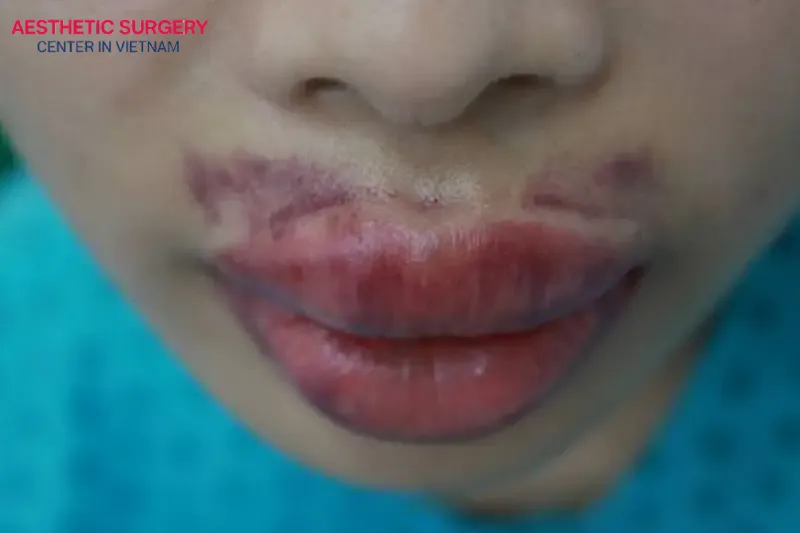
Severe complications
These are rare but can be serious if not addressed promptly.
- Vascular occlusion: The most dangerous complication. If filler is accidentally injected into a blood vessel, it can block blood flow, leading to skin necrosis, blindness, or even stroke.
- Infection: If the injection tools are not properly sterilized or if the procedure is not performed under hygienic conditions, bacteria can enter the skin and cause an infection.
- Granulomas: Chronic inflammatory responses that result in hard lumps at the injection site.
- Severe allergic reactions: May cause full facial swelling or difficulty breathing.
- Unsatisfactory results: Such as facial asymmetry or an overfilled, unnatural look.
- Filler migration: The filler can shift from its original injection site to other areas of the face.
Care after filler injections at Aesthetic surgery VietNam
Proper aftercare following a filler injection is essential to ensure optimal aesthetic outcomes, minimize risks, and help the filler stabilize and last longer. In Vietnam, doctors and cosmetic experts often provide detailed post-treatment instructions. Below are the most commonly recommended aftercare guidelines:
What you should do?
- Cold compress: During the first 24 – 48 hours, gently apply a cold compress to the injected area to reduce swelling, redness, and bruising. Never place ice directly on the skin, but instead wrap it in a soft cloth or use a gel ice pack to prevent cold burns.
- Gentle cleansing: After the first 6 hours, cleanse your skin with saline solution or clean water. Be gentle and avoid scrubbing the injection site.
- Stay hydrated: Drink plenty of water to help the filler (especially hyaluronic acid (HA) fillers) bind to moisture, fill the area effectively, and stabilize.
- Eat healthy foods: Consume plenty of green vegetables, fruits rich in vitamin C, and soft, easy-to-chew foods (especially if filler was injected in the chin, cheeks, or lips) to avoid excessive facial movement.
- Sleep on your back: Use a high pillow and sleep on your back for the first few days to avoid putting pressure on the treated area, which could shift the filler.
- Follow your doctor’s instructions: Take prescribed medication (if any) and return for follow-up appointments as scheduled.
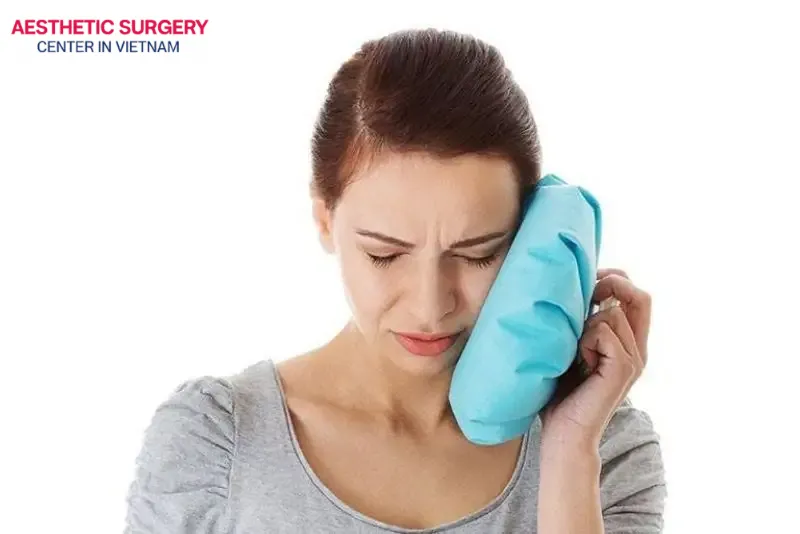
What you should avoid?
- Do not touch, press, or massage: Avoid touching, pressing, or massaging the treated area for at least 1–2 weeks. This can deform the filler or cause it to migrate.
- Avoid high heat exposure: Stay away from saunas, hot showers, heating devices, or direct sunlight. High temperatures can cause the filler to break down or become unevenly distributed.
- Limit physical exertion: Avoid intense workouts or vigorous activity during the first 48 hours, as increased blood flow may worsen swelling or bruising.
- Avoid certain foods: Refrain from eating seafood, beef, chicken, sticky rice, or water spinach. Avoid stimulants, no makeup.
Strictly following these aftercare guidelines will help you achieve the best possible aesthetic results, ensure safety, and extend the longevity of your filler.
As we’ve explored, filler injections are widely favored in Vietnam and globally as a non-surgical aesthetic solution. However, like any cosmetic procedure, they still carry certain risks, especially when performed at unqualified or unlicensed facilities.
To protect your health and beauty, always choose a reputable aesthetic clinic, with experienced doctors, and ensure they use 100% safe, certified fillers to avoid unwanted risks like Aesthetic Surgery Center.







Comment on the post